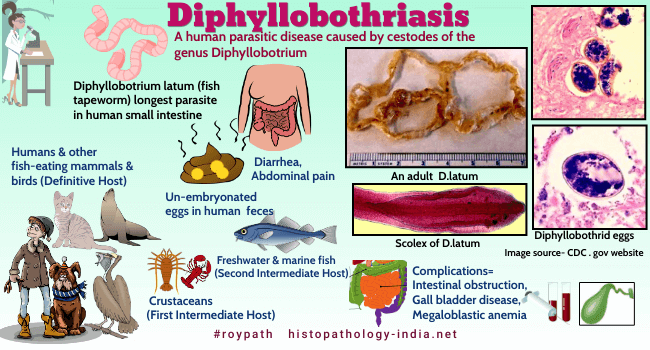|

Custom Search
|
|
Infectious Disease Online Pathology of Diphyllobothriasis
|

|
Diphyllobothriasis, a human parasitic
disease caused by cestodes of the genus
Diphyllobothrium (also known as broad tapeworms or
fish tapeworms). Besides humans, definitive hosts of
Diphyllobothrium include
fish-eating mammals and birds. Infection usually is contracted
by eating raw or undercooked fish. First stage larvae are found in
crustaceans, and second larvae develop in fish.
Diphyllobothrium latum is
one of the longest intestinal tapeworms in humans.
#histopathology #pathology #Diphyllobothriasis #Diphyllobothriumlatum #tapeworm #cestodes #fishtapeworm |
|
Tapeworms or cestodes are hermaphroditic parasites, which can live for considerable periods of time in the human gastrointestinal tract. Fish tapeworm (Diphyllobothrium species) are endemic in various parts of the world, the commonest species being Diphyllobothrium latum. Diphyllobothriasis is found principally among fish-eating people in the Scandinavian countries, Brazil, Russia, and inparts of Asia including Japan, Malaysia, Korea and Saudi Arabia. In the United States it is found in northern Michigan, Wisconsin, and Minnesota. The infection is extremely rare in tropical areas. The causative agent, Diphyllobothrium latum (fish tapeworm), measures between 3 and 10 meter (10 and 33 feet) in length and is composed of 3000 or more proglottids. Humans and other mammals, especially dogs, acquire the infection by eating uncooked fish or fish products. The worms live in the small intestine. The presence of multiple worms is not uncommon. Infected persons may be symptomless or may suffer from gastrointestinal disorders, especially abdominal pain. Complications include intestinal obstruction and gall bladder disease caused by migration of proglottids. Occasionally a megaloblastic anemia (bothriocephalus anemia) is seen, especially when the worm is implanted high in the small intestine. The exact mechanism for the production of anemia has not been fully elucidated. One explanation for anemia is that the worm produces an enzyme that interferes with the association between vitamin B12 and the intrinsic factor. The uncomplexed vitamin B12 is not absorbed in the ileum and is available for the worm’s utilization. Megaloblastic hyperactivity of the bone marrow and even central nervous system degeneration may be noted in some patients. Differential diagnosis should be made primarily between tapeworm anemia and genuine pernicious anemia. The following findings constitute evidence of tape-worm anemia: - Free hydrochloric acid in the gastric juice; - Remission after the worm cure without additional therapy, - Schilling test value that becomes normal after the expulsion of the parasite.
|
|
|
Visit:- Dermatopathology Online

|
Copyright © 2022 histopathology-india.net
